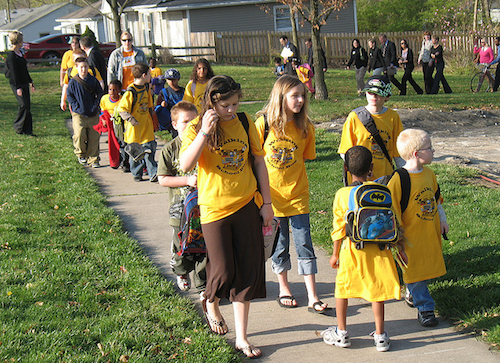Back in the day, walking to school was a rain, sleet or snow kind of affair. Kids bundled up and hit the road; that’s just how it was. Concern for traffic was minimal and the term “stranger danger” hadn't become part of the lexicon of childhood.
This is no longer the case. Far from setting kids loose into the streets, many parents are driving them from door to well-supervised door. This trend contributes to out-of-shape kids, traffic congestion in and around schools, and air pollution.
But there’s a fix. What if kids could walk to school, escorted by a trusted adult, in the company of their peers? Enter walking school buses, the brainchild of public spaces pioneer David Engwicht.
This year, we’ve seen Mutual Aid in Motion.
From scaling sharing hubs to Mutual Aid 101 trainings, we’re helping communities build the tools they need.
Every dollar fuels lasting resilience – proving that when we move together, we all move forward.
A walking school bus is pretty much what it sounds like. It can be as simple as two neighbors taking turns walking a few kids to school or elaborate enough to facilitate a large group of kids, with timetables, pickup points and a team of volunteers. Below are some tips on starting a walking school bus in your neighborhood, taken from WalkingSchoolBus.org and an interview with Ian Thomas, former executive director of PedNet in Columbia, Missouri and champion of the walking school bus.
Start Simple
Are there neighborhood kids who are close enough to walk to school but could use a little supervision for safety? Start talking to the neighbors and see if there’s an interest.
Scheduling Details
Who wants to be involved? Where do they live? Pick a route and take a test walk. Talk about scheduling and frequency of the walking bus. Will it be every day? Will it be morning and afternoon?
Safety
There are a lot more cars on the roads today than there were in the 1960s when approximately 50% of kids walked to school. What kind of safety training will volunteers receive? What kind of safety training will the kids receive? As Thomas notes, “Roads are not made with pedestrians in mind, let alone children.” WalkingSchoolBus.org’s Guidelines to Talking to Children About Pedestrian Safety is a good place to start.
Find Partners
Talk to school officials, local law enforcement officers, community leaders and other parents. The more awareness and momentum behind the walking school bus program, the more opportunity to facilitate safe transitions, reduce carbon emissions and build community.
Start the Bus
The details have been worked out, the volunteers are in place and the kids are ready, so start walking. Know that some fine-tuning may be necessary. Keep the lines of communication between parents, volunteers, kids and the school open and work out kinks as they arise.
Let it Grow
As your walking school bus program grows, introduce it to other families and neighborhoods. Successfully modeling a program may lead to more elaborate programs in other neighborhoods, schools or cities. Don’t be afraid to think big. The National Center for Safe Routes to School administers $600 million in federal funding for programs that advocate for safe, active, environmentally-responsible ways to get children to school.
Do you have experience with a walking school bus? Do you have any additional tips or how-to’s to offer? Let us know in the comments.

